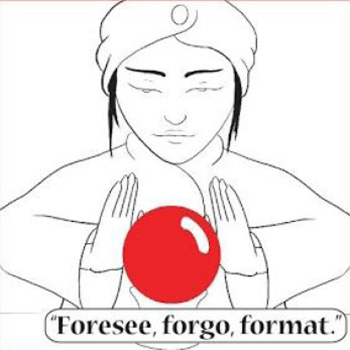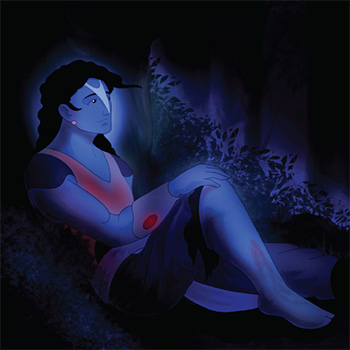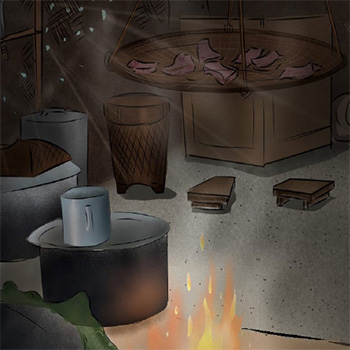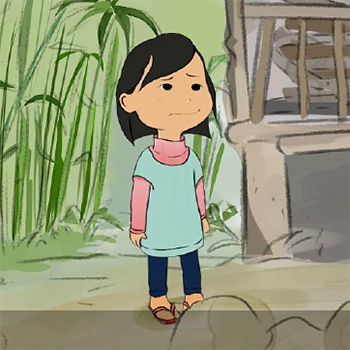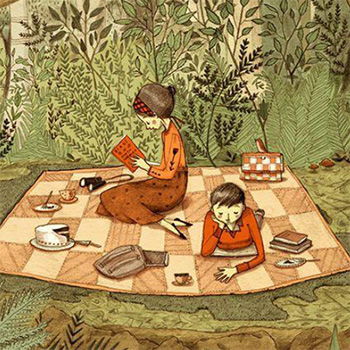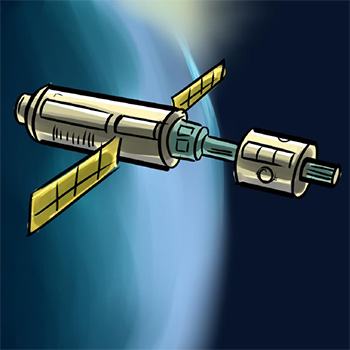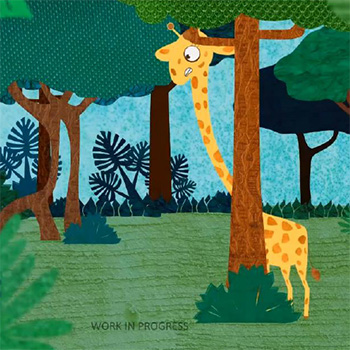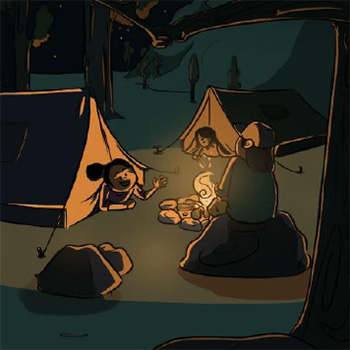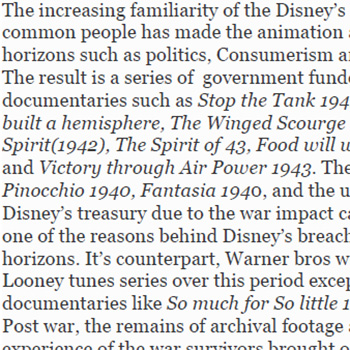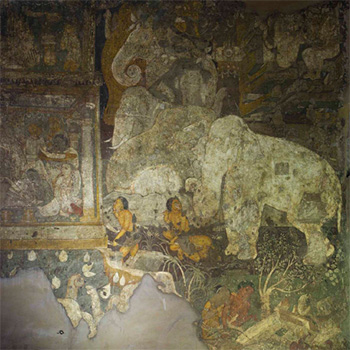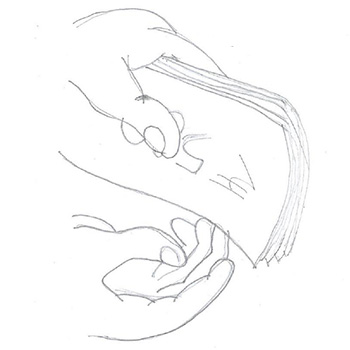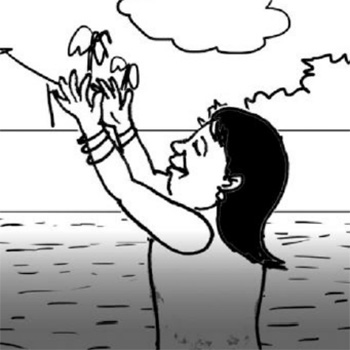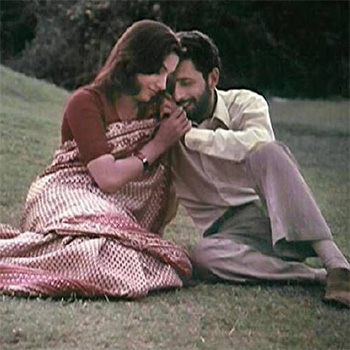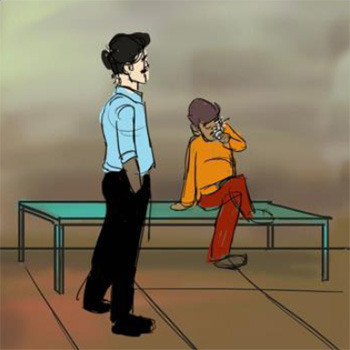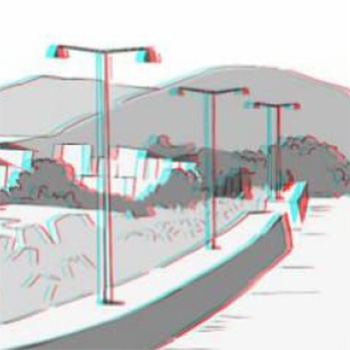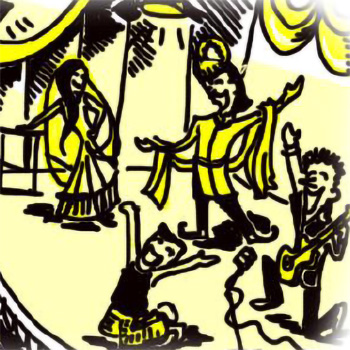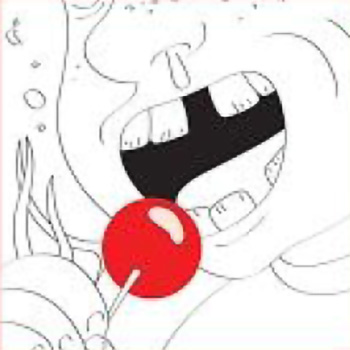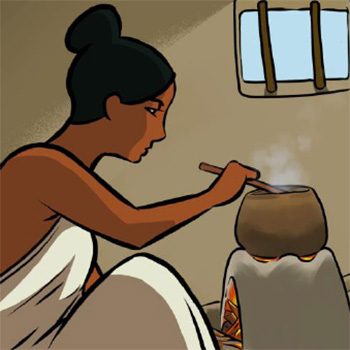Animation Design
Batch 2017-2019
(42 items)
Animation DesignBatch 2017-2019
(42 items)
(42 items)
Sound Symbolic words in Indian comic books- A study on textual representation of sounds in comic books
by Abhilash Saxena
by Abhilash Saxena
Sound symbolic words (SSW) are the visual representation of the sounds in comic books. It helps the reader to imagine the ambience of a particular panel in the comic and hence plays an important role in enhancing the mood of the panel. Consider examples such as CRASH, DHADAM, BOOOMM, and so on. An SSW is designed by two elements: (a) the form, i.e., the visual representation of the SSW, and (b) the word itself that represents the sound. This paper focuses on the following topics: 1) The determination of a suitable SSW for some common sounds through a survey. 2) An individual study of SSWs in the comedy genre of Indian comic books. For the first topic, forms were created for the survey and were distributed online and offline to take inputs from participants. The forms were then analysed based on the data received. For the second topic, a bunch of Indian comic books (mostly Raj comics) of the comedy genre were studied, and observations were recorded.
Details >>Ekabhuya Animations
by Abhilash Saxena
by Abhilash Saxena
Ekabhuya Animations generally works to produce promotional videos for their clients. Most of the videos are a hybrid of 2D animation with live action. The director of the studio is Janmeet Singh. I worked on a project that is Janmeet's personal project, and he has been planning it for a while. It's still in the pre-production phase, as he is still working on the story. My mentor Mr Janmeet Singh is working on a graphic novel, "Toxic". The main aim of this internship was to focus on character design and learning the basics of layout design. The novel is about some of the cops working undercover as drug lords to stop the increasing addiction to drugs among the youth. I was told to explore some characters based on the theme. Though not much detail was given about the characters, I was told just to explore some characters based on the theme. Another project that I worked on is a webcomic for which they wanted me to explore stylised cartoon faces. There were no constraints for character design. Apart from this, I worked on digital paintings, watercolour paintings, gesture drawings and composition layouts on a daily basis.
Details >>Cow Protection
by Abhilash Saxena
by Abhilash Saxena
The cow is considered a holy animal in Hinduism. It is believed that there are around 33 million gods in a cow's body. Needless to say, it is worshipped all over the country. Apart from just being a religious symbol, it plays the ground role in the dairy industry. However, there is not just one religion in India; it's a diverse country where the culture and beliefs of people change every 100 miles, and to live in peace, one must respect others opinions and their way of living. Due to violent communal riots that happened in the past, cow slaughter is banned in many states of India, and recently, in 2015, even buffalo and bull slaughter was also banned completely in some states. It hit the livelihoods of many people overnight. There have been numerous debates over this topic, and there have been cases of lynching of people over the suspicion of cow slaughter. Through this film I want to raise awareness among the people who are being drawn to hatred and violence due to the religious propaganda of certain groups.
Details >>Childhood Memories
by Abhilash Saxena
by Abhilash Saxena
I have been brought up in a joint family; there were around 25 members in my family, and 15 of them were us kids. As most of us were of the same age, we shared a lot of memories together. I belong to a small town, and it has its own perks. There are a lot of people who know each other; neighbours were like family, so the whole locality becomes like one. It is the one thing that I miss the most now. However, my childhood is full of stories; there are a lot of stories that I wanted to tell, and there is humour in almost all of them no matter how serious they appear then. I like making humorous films, and I wanted to work on such a film. This story shows the love for Kulfi (ice cream) of two brothers. Both are willing to do anything to get kulfi; they ask their parents, they threaten each other, they fight and they steal too. But there is an innocence in all of their acts. I wanted to create a bit of nostalgia with the backgrounds, ambience and sounds. Basically, it's a slice of life with some added humour.
Details >>Motion Comics- Immersion in the Age of Interactive Storytelling
by Abhishek Soni
by Abhishek Soni
The introduction of comic books in our society was a great godsend because, for the first time, people realised that not only were the characters they had only previously read about actually talking and acting out, but also the world they belonged in was designed for them. Thus began the greatest revolution of transforming the world of comics to become increasingly realistic in order to enthral you in their yarn of illusions. This research focuses on finding a technique of interactivity in comics where readers can choose their own narratives as an alternative to motion comics being the future of comic books. Furthermore, it also aims at researching the amount of presence and immersion that the reader achieves while vexed into the narrative and whether it enriches one’s experience as a consumer of ‘stories’.
Details >>Avalokan
by Abhishek Soni
by Abhishek Soni
The aim of this movie is to provide the right perspective to observe and understand the things around them and inspire the children to preserve their curiosity. People who display a high level of creative energy are simply people who retain the curiosity in the form of childhood spirit despite the pressure and demand of adulthood. Without getting overwhelmed with the reality around, this spirit manifests itself in their work and in their way of thinking. Children are naturally creative; they actively transform everything around them and play with ideas and circumstances. The natural creativity of children is limited; what they require is the right apprenticeship or guidance to the right perspective of observing the reality around them. As such, in adulthood they not only develop profound knowledge of the subject, but also their mind is open to alternative ways of seeing and approaching problems.
Details >>Indian History and Mythology
by Abhishek Soni
by Abhishek Soni
The Fall of Dwarka is the action saga from the life of the most worshipped Indian deity, Lord Krishna. Working on Indian history & mythology as a subject to study for my P3 has been a topic connected way back to my childhood, as we grew up watching Ramanand Sagar’s Ramayana, Shree Krishna, Mahabharata, Vikram Betal, etc. These series were not as advanced in terms of visual development, but they provided good moral ground. In the late 90s, Yugo Sako’s Ramayana: The Legend of Prince Rama aired, which made a big impact on the lives of rural kids, as the concepts, animation techniques and story treatment were quite unusual from what we had been watching regularly and inspired us with the possibility that we could give wonderful animated films with our Indian stories. As a part of this P3 project, I preferred to research the life of Krishna, as there are still many parts of his life that people are unaware of. The city of Dwarka is one of them. The city was built on command of Lord Krishna with land that emerged out of the sea (over the Gulf of Khambhat and near the coast of modern Dwarka at present). The ruins of the ancient city are today found submerged underwater, which brings out the fact that all of the stories and folk tales were not mere mythology but an actual history. There were a series of bad omens and curses cast on Krishna which led to the destruction of the Yadu clan and the death of Lord Krishna; thereafter, the entire city was flooded and submerged underwater.
Details >>Experiments In Stereoscopy
by Alok Hasnu
by Alok Hasnu
A study on stereoscopic comic books and their level of immersion for the reader in comparison to a normal comic consisting of 2D images. This study has been conducted as a part of DRS 2019, under the title of Experiments in Stereoscopy, with comic books in focus. There are several factors involved for a person to approach a comic book, like the visual storytelling, narrative, artwork, nostalgia, or just a mild interest. If the experience of reading a comic book can be enhanced even further with stereoscopy, how does that affect the immersion of the reader? That is the focus of the topic. The findings have been documented with the help of user testing, their responses analysed and conclusions derived. A few other observations have also been made, which have been documented in this research paper.
Details >>Internship at iRealites Technology Pvt. Ltd.
by Alok Hasnu
by Alok Hasnu
The purpose of the internship was to learn and witness how production goes on in an animation studio. Initially, time was allotted to get familiar with the software and tools. Then I was asked to make storyboards for nursery rhymes. Later, they shifted towards storyboards for advertisements (live-action/animated). Moving forward, I created assets and concept art for IP development. Finally, I was asked to create cost-effective animation content for a narrative. I also screened animated short films for exposure in terms of concept and techniques of animation. The most important thing I have learnt from the internship is clear communication and transparency among the teams in a studio. Also, the designs and ideas from the mind of an individual should be feasible considering the deadlines. After this exposure I am confident for the upcoming projects as an animator.
Details >>Cross Cultural Acceptance of Ethnic Food
by Alok Hasnu
by Alok Hasnu
Food can be an identity of a community or a culture. The term ethnic food categorises people and their culture. Fermented foods are an intrinsic part of the ethnic food of a community or tribe. Each ethnic group has its own method of fermenting foods. The purpose is for the taste, nutritional enhancement and, most importantly, for preservation economically. Due to the given climatic and topological conditions, farming was not the best way for the source of food; thus, fermentation and preservation of food were adapted. Most of the people tend to associate the aroma of the food with its taste. Most of the fermented food does not give out a good aroma; some give out a foul smell, and most people do not enjoy it, except for the ones who are familiar with that kind of food. Ethnic and fermented foods are also an identity of a community. Most people from northeast India face discrimination based on these grounds. Since the majority of the people are not aware of the types of food they eat, in most case scenarios they outcast them, leading to discrimination.
Details >>Music as a Language
by Alok Hasnu
by Alok Hasnu
Music is a mighty means of communication. It's a medium through which emotions and intentions can be expressed even without a spoken language. But there exist languages which are not verbal and are just a tune or a melody. People in different parts of the world have been practising the whistling language. In places where this is practised, it is termed as the bird language inspired by nature. These languages are mostly practised in hilly regions. Unfortunately, due to the complexity and lack of practice of these languages, this rich cultural heritage is dying out and on the verge of extinction. In India there exists a similar practice which is a rich cultural heritage. It is not a whistling language, to be precise, but it is unique on its own and is used as a means of communication. Nestled in the hills of Meghalaya, Konghthong is the village where this is practised. It is also known as the whistling village of India. Jingwrai lawbei is the name of the practice where a person has a unique tune as an identity. This tune is devised by the mother at the time of the birth to express the love for the baby.
Details >>Motion Comics- Immersion in the Age of Interactive Storytelling
by Anindita Mondal
by Anindita Mondal
The introduction of comic books in our society was a great godsend because, for the first time, people realised that not only were the characters they had only previously read about actually talking and acting out, but also the world they belonged in was designed for them. Thus began the greatest revolution of transforming the world of comics to become increasingly realistic in order to enthral you in their yarn of illusions. This research focuses on finding a technique of interactivity in comics where readers can choose their own narratives as an alternative to motion comics being the future of comic books. Furthermore, it also aims at researching the amount of presence and immersion that the reader achieves while vexed into the narrative and whether it enriches one’s experience as a consumer of ‘stories’.
Details >>Summer Internship 18
by Anindita Mondal
by Anindita Mondal
This internship, as a part of our P-1 project, was a great learning curve for me. From getting industry-level experience to insights into much larger fields, this helped in a personal as well as a professional growth for me. For which, I am extremely thankful to the faculties and authorities of IDC for giving us the opportunity to venture out of our comfort zone and get a glimpse into what the rest of our lives would look like.
Details >>Old Age- The Yesteryears of our Society
by Anindita Mondal
by Anindita Mondal
The plight of the elderly in our country and elsewhere is really a sad tale of events where most of them don't get the love and respect they deserve. The moment they become dependent on the next generation, very often, they are kicked out of their own home. Very few get the opportunity to stay in an old-age home. The rest simply end up spending the remainder of their lives on the streets. Suffering the unshaken winters and the insatiable hunger to survive. My film deals with the plight of one such lady who has found her way onto a corner of the streets and is now reduced to begging. The story is told from the point of view of a young girl, who has no idea how unforgiving the real world could be. So, when she finds the old lady trying to beg on the streets, she doesn't know what the lady actually wants. So, she ends up giving the only valuable thing she had on her, her toffee. What begins is an epic journey of these two unlikely friends and the bonds that get carved onto their souls. And no matter if the seasons change or the years turn, the love that they each hold for the other doesn't waver. Everybody has a story to tell. And an old woman who has a lifetime's worth of stories to tell simply wants to be heard.
Details >>Deep Space
by Anindita Mondal
by Anindita Mondal
Everybody yearns for freedom. Whether it is a space pilot chained by his desire to set himself free from Earth's everlasting gravity or a little boy's earnest attempt to fly away like a bird from the four walls of his only world, everybody yearns to be free. For a little push, for a leap of faith, for that one second of immense bravery that will set us on a path of eternal liberation. For a tomorrow that is different from today. What follows is an adventure of a lifetime that takes you across the stars and the Milky Way, dancing with the Great Bear or soaring through the asteroid belts lightyears into your hopes and dreams until all you are is raw desire and stardust. Everybody yearns for freedom in one form or another. And out there in infinite space, where every way is up and every way is down, one must learn the boundaries of being free.
Details >>Animation Based on Indian Art Forms
by Deepam Jain
by Deepam Jain
When Indian art is thought of, many things come to mind. From the extremely detailed Kalamkari art to the very simplistic miniature paintings. There is a huge variety from place to place, culture to culture. One thing common in all of them, though, is they all tell stories. These stories have been passed down through generations via oral culture and artistic expression. Unfortunately, despite all the richness in art, Indian art is rarely seen in animation. This paper takes the art of Jamini Roy as an example and focuses on methods to bring his stories to life.
Details >>Summer Internship Projecet- Girgit Studios
by Deepam Jain
by Deepam Jain
The main aim of this internship was to get into a studio environment and observe and learn how things are done in a professional environment and, of course, to get better at the art of animation. I worked on three different projects during these two months, and all three were great learning experiences, as is discussed further in this report. Apart from the projects, I believe a lot of learning also happened during breaktime or in general interaction with the officemates. The office environment was quite rich for learning; all the people were really friendly and were more than happy to answer any of my queries. Frequent discussions over projects happened; film analysis was a daily routine. But apart from the technical and artistic side of animation, I also got a little insight into the legal and financial aspects of running a studio, and most importantly, I understood how “work” can be really fun and that that is how it should be done. I think the internship at Girgit Studios was a really great experience, and all the things that I have learnt in these two months would help me in accomplishing my dreams, and that too in a happy fashion.
Details >>Human Bonding
by Deepam Jain
by Deepam Jain
Human beings are one of the most social species in the world. We meet people, we involve ourselves with them and we bond with them. Some bonds we form from birth, like the bond with our parents. Some we develop over time. I find beauty in the uniqueness of each bond. Parental bond, for example, is about love, care and support. Friendship is about fun and mutual understanding. But the most special bond that I find is that of siblings. The bond that siblings share is almost all-encompassing. They are your best friends, worst enemies, guides, rivals, inspiration, aspiration, angels, demons and, in some cases, even subjects for experiments.
Details >>Episodic Animation
by Deepam Jain
by Deepam Jain
This project is the first two episodes of the TV show I am working on – Silly Siblings. Silly Siblings is a collection of day-to-day stories of two brothers presented in an episodic format. Each episode is a slice of life of the two brothers, Niku – the outgoing, sport-loving elder brother – and Piku – the carefree and creative younger brother. Piku and Niku are polar opposites in the way they approach things; Niku likes to plan and execute, while Piku likes to savour the whole journey as if there is nothing else to care about. They would often pull each other’s leg for their ridiculous ways of doing things. But most importantly, they balance each other and can't live without the company of the other. Through Piku and Niku, I have aimed at celebrating the amazing bittersweet relationship that siblings share and to evoke humour and nostalgia among the audience.
Details >>Animated Documentary as a Genre
by Divakar SK
by Divakar SK
Animated documentary is a genre which predominantly uses animation form for telling nonfiction stories. It’s an independent genre in itself that differs from live-action documentaries in terms of the very visual differences and stretching the storytelling boundaries of conventional documentaries. It’s been exactly 100 years since Winsor McCay made The Sinking of Lusitania, the officially recorded first-ever animated documentary in cinema history. Ever Since the use of the animation medium for documentary filmmaking had largely been unexplored for the next 20 to 25 years till the mid-40s, apart from Fleischer Studio’s works such as Einstein’s Theory of Relativity (1923), which had used animation for a kind of educational documentary. Over the Silent era, it's mostly been a lot of experimentation that animation has undergone, both in terms of form and narrative. The animated works of German legends like Hans Richter, Walter Ruttmann, Oskar Fischinger and Viking Eggeling were notable in this period but were overshadowed by the success of their German live-action counterparts like F.W. Murnau and Fritz Lang. Even though the success of R.J. Flaherty’s documentary films had a predominant effect on live-action documentary filmmaking over the next decade, the arc of animation was still set away from the documentary genre.
Details >>Life In the country side- Paint on Glass Animation
by Divakar SK
by Divakar SK
In this 21st century, life has become incredibly fast and restless. In short, 90 per cent of the urban people are originally rural, and when they get urbanised, their age-old native lifestyle goes for a toss. Over the years, they weren't the same people. People lose track in the theatricality and the grandeur of these modern-day mirages. I wonder where we went off the track, and sadly I realise we were never on the track all these years. In this quest for well-being, both in terms of personal and universal means, I have found the fact that re-learning the things is the only way to learn the art of well-being on this modern planet. Nature will help in this process. The human race has always been in closer relation with nature for millions of years, and the fact they adapted to the way of living is that they have very well realised their place in the ecosystem. They also realise the fact that every single life on this planet is linked by a whole lot of cosmic associations. "A rock broken in one corner of the forest will suffocate the fish swimming in the stream running in the other edge of the forest." It's such a super-linked ecosystem. The fact that our planet is full of ecological and sociological problems on every level of the pyramid is just because we forgot our place in the ecosystem. It's a serious blunder that is questioning the fate of this planet, and to sever this fact, we're just ignorant towards this fact and are purposely made blind towards all these so-called modern-day lifestyles. That's where I thought of the fact that we need to re-establish our relation back with the ecosystem. In many rural regions and tribes around the world, the lifestyle is still intact after ages of living in harmony with nature. It's time we start observing and learning from the life in the countryside and develop sensibility and respect towards nature on every level of the pyramid. I believe it's the way to achieve a sustainable lifestyle on this dying planet. Through this project I have made my tiny speck of a move in shedding light on this subject, a subject that we are purposely taught to close our eyes to whenever it floats up. I hope I could attract a few eyeballs on this noble cause essential for the very sustenance of this planet.
Details >>Animated Mockumentary- Mixed Media Animation
by Divakar SK
by Divakar SK
Despite every city having its own signature identity, there's something very common between most of the cities around the world, whether it's a US city, an African city or an Indian city. Globalisation has gone a long way in blurring down the blockades between all these worlds. The advent of cinema, television and printed media over the past century has played a mammoth role in bringing the corners of the world into every person's home. And the people in the huge cities are the ones who get directly influenced by these agents that trigger rapid dispersal of global trends instantaneously. Over time these cities have developed a culture of their own which is highly fluctuatory, contagious and seasonal. It is called aspopular culture. Popular culture is a phenomenon that operates much intricately on the mental levels of the society. With the arrival of the internet, the radius of this phenomenon has broadened to a wider scale, and it has developed its own traits of behaviour over the years. The idea of people being in sync with the top trending list is a key driving force behind modern-day popular culture. Amidst the conspiracies, it's very interesting to observe how people and the internet breathe as a whole, like a single huge organism. But like a candy, the trends in these virtual worlds come with a shelf life, and they are meant to be highly volatile at times. No trend stays at the top of the pyramid for more than a week in today's world. Every trend pops out of elsewhere, is discussed over and over, brings in a lot of online commotions and celebrations, and then just disappears into thin air the next morning. What's more amusing is the fact that there is always a neverending supply of these trends that always switch over and keep our skull space occupied. No matter to what extent people try to blanket them away from these trends, they are either directly or indirectly pushed into the theatricality of the proceedings of this modern-day popular culture. I strongly feel this phenomenon has silently shaped up the cities, as they decide a lot of political and corporate factors sitting right inside every person's head and dictating people day in and day out.
Details >>Art History and technology for the Museums with Ajanta as a case study
by Eshwar Kumar G B
by Eshwar Kumar G B
India is a diverse country which has a glorious history in art and culture from past centuries. We have the responsibility to cherish our artefacts or should be aware of them so that they are not fragile. There are numerous magnificent structures in India. The Ajanta Caves are one among them and also a world cultural heritage site. The paintings and sculptures in the caves are getting fragile, and the tourists who visit the caves are unable to understand the paintings due to several reasons, like some portions of paintings having dissipated, which is resulting in difficulty interpreting the information of the art, especially the narrative paintings because they are not in a linear pattern. Therefore, several measures are taken by ASI (Archaeological Survey of India) for conserving the historic art. Some people are also trying to digitalise the paintings before they get fragile. Therefore, even a design team from IIT-Bombay also takes a step ahead to conserve the historic Ajanta art on various platforms like digital and immersive virtual reality. The aim is not only to preserve and reconstruct the artefacts digitally but also to make the world understand the potential of art by giving the right information about the exhibits and communicating the stories of narrative paintings using animation as a medium so that it will be useful for education and researchers to know them in a better way. The other purpose is to bring Ajanta to the people who are unable to visit the site in person. In this paper, I would like to present the insight on why Ajanta is for contemporary museums, hands-on experience, advantages of virtual experiential museums, and how the technology is significant for museums.
Details >>
Summer Internship Project Presentation at Toonz Animation India Pvt.Ltd
by Eshwar Kumar G B
Details >>
by Eshwar Kumar G B
Details >>
Human animal Bond
by Eshwar Kumar G B
by Eshwar Kumar G B
My story deals with two various types of people whose intention is to be good and very close friends with the elephant and the other side of humans who want to show their power or strength by killing such a massive animal just to make themself a great hunter and a very strong man. It also deals with the people who trap them to get benefits out of them instead of making them be free in their own land. In the other way, I want to show how an animal can be so loyal to the people; though they try to trap them, still animals are so helpful and do all the work which is said to be done to them. And also an animal can be so close to the one who loves them and can go to any extent in saving the person whom they love. Here the story goes on with a man and an elephant from their childhood; they grow up and become so friendly to each other that they can’t be away for long. I just want to portray that elephants are being slaughtered by some of the humans to make money; at the same time, the rest of the humans are trying to protect these species; this is a huge hazard in the current world. In future, if these species are existing on the planet, we still may not find them with huge tusks.
Details >>Global Warming
by Eshwar Kumar G B
by Eshwar Kumar G B
This animated short film is based on the story of a man who did not leave his place after the apocalypse that occurred due to global warming and started living on a hilltop along with a dog, whom he met after losing everything in his life. He treats his dog as his kid, although the dog motivates him every day by making him feel that he is not all alone. The reason for him to still live in the remote area is that it is bonded with his memories of his sweet daughter, whom he loves a lot. He knows that she won’t be returning but is still looking for her every day. He struggles a lot in his old age but never gives up. The only sign of his daughter at present is a photo frame and her drawing, which pulls him back to his past, revealing the story of them being together and the destruction of nature separating them forever. This story also states the level of people that had been reached after the apocalypse due to global warming. We will be the cause of losing our children and grandchildren and making them suffer and lack food, water and shelter if we continue to be indifferent to the consequences.
Details >>Animated Documentary as a Genre
by Harikrishnan S
by Harikrishnan S
Animated documentary is a genre which predominantly uses animation form for telling nonfiction stories. It’s an independent genre in itself that differs from live-action documentaries in terms of the very visual differences and stretching the storytelling boundaries of conventional documentaries. It’s been exactly 100 years since Winsor McCay made The Sinking of Lusitania, the officially recorded first-ever animated documentary in cinema history. Ever Since the use of the animation medium for documentary filmmaking had largely been unexplored for the next 20 to 25 years till the mid-40s, apart from Fleischer Studio’s works such as Einstein’s Theory of Relativity (1923), which had used animation for a kind of educational documentary. Over the Silent era, it's mostly been a lot of experimentation that animation has undergone, both in terms of form and narrative. The animated works of German legends like Hans Richter, Walter Ruttmann, Oskar Fischinger and Viking Eggeling were notable in this period but were overshadowed by the success of their German live-action counterparts like F.W. Murnau and Fritz Lang. Even though the success of R.J. Flaherty’s documentary films had a predominant effect on live-action documentary filmmaking over the next decade, the arc of animation was still set away from the documentary genre.
Details >>Internship Report
by Harikrishnan S
by Harikrishnan S
Genial Nous Media Pvt Ltd, Bengaluru, was founded in 2013. The company has 2 directors, Mr Jim Mathew and Mr Abhilash Jose, and they work on various projects like signature films, presentations, reports, content creation, interactive videos for applications, etc. The one-month internship with Genial Nous Media, Pvt Ltd in Bengaluru was done as part of the MDes programme in IDC, IIT Bombay. It was a wonderful experience, as I got to meet new people working in the industry and work on various types of projects, ranging from signature films to interactive videos. During the first week, I was given the task of collecting the data required for making the signature film of an upcoming film festival in Kerala. The concept was a collage-type quick journey through the diverse landscape of Kerala, while artists of different traditional performing arts will be seen randomly. It was a very good experience, as I prepared a lot of sketches of the performing art forms as well as the backgrounds of the frames. Another work is a short video for a mobile application. It is an interactive video and is being made as a loop, i.e., the story ends where it began. Hence, the user will not be able to figure out the exact beginning and ending of the video. It was a unique experience, as I could work on the storyboard and animation of that video.
Details >>Communal Harmony
by Harikrishnan S
by Harikrishnan S
India is a country where people of different religious, racial, cultural and lingual identities have been living in harmony. However, with the passage of time, various incidents are badly affecting the communal harmony in different parts of the country. Communalism is a big threat to the secular, socialist and democratic polity. A lot of communal incidents are happening every day, which is not good for the democracy. In a country ruled by the rule of law, the hallmark of democracy is communal harmony. Good governance has to be maintained.
Details >>Folktale from Kerala
by Harikrishnan S
by Harikrishnan S
India is a land of a lot of myths and folktales. Most of the regional stories are so interesting that they can be turned into wonderful pieces of art through illustration and animation. This 2D animation film is an adaptation of 'Kolathiriyum Samoothiriyum', a story from 'Aithihyamaala', a collection of century-old stories from Kerala that cover a vast spectrum of life, famous persons and events. It is about the rivalry of the rulers of two regional kingdoms, packed in humour. Set in the later mediaeval period, the film explores various aspects of the northern part of the present-day Kerala state, like culture, geography, architecture, cuisine, etc., through visuals as well as dialogues.
Details >>The depiction of Romance in Popular Film-Media in India
by Meera Behera
by Meera Behera
This project is about how Bollywood has been depicting romance over four decades, that is, from the 80s to the 2010s. To know the evolution of portraying romance in Bollywood, a small interview was conducted as primary research, and watching Bollywood romantic movies from the 80s to the 2010s has been followed. From primary research, some of the insights are positive, and some are negative as well. But most people have spoken negatively about the portrayal of romance in Bollywood. From the secondary research, this report has very many insights into the problematic, negative, and positive parts of Bollywood romance.
Details >>Internship at Humaramovie
by Meera Behera
by Meera Behera
Humaramovie was founded in the year 2011. It has its own YouTube channel with 4.7 lakh subscribers. It airs short films every week with an average of 1 million likes. It is also known for providing platform for young filmmakers. It is a feature film which aggregates four different short films mentored by 4 mainstream directors, namely Raju Hiran (3 Idiots), Imtiaz Ali (Jab We Met), Omung Kumar (Mary Kom) & Vikramaditya Motwane (Lootera). "ADI SON AL" is one of those short films where I was a part of its production.
Details >>Paranormal
by Meera Behera
by Meera Behera
The film is about a cat who cuts everyone’s path, and it is believed by one of the characters called Sundar that everyone dies because of the cat, whereas the other character, Kumar, from the film believes that the cat is not the cause of everyone’s death and also believes that the cat is like other cute animals and does not bring death or bad luck. This film is motivated by our Indian culture, as we all know that in India it is widely believed that the cat brings bad luck or death. But the objective of the film is to break that superstition about the cats. As an outcome, the film is being made in 2D animation, which tells the story of two friends, Sundar and Kumar, where Sundar believes in all blind beliefs about the cats and Kumar who doesn’t believe in superstitions.
Details >>Social Acceptance of Homosexuality
by Meera Behera
by Meera Behera
The film represents the LGBT community of our country. The film has focused on only one spectrum of this community, which is “homosexuality”. As we all know, being a homosexual in our Indian society is a big taboo and is not accepted by our society. Aditya is the main character from the film who dreamt of himself as his young version as a heterosexual in a world of homosexuals, and he is being treated the way our society treats the homosexuals of our society. The motivation for the film came from my friends who belong to these minorities. The objective of the film is to tell everyone that these minorities go through a lot of problems in their lives, like they have to fight for their right with the society and parents even after the Law Section 377 got struck down in the year 2018, September. The law did not make any changes; the condition is the same as it was before. So the main objective behind this project is that if the parents can accept their homosexual kids as they are, their lives could become a little easier for them. The film is being made in the medium of 2D animation.
Details >>Experiments In Stereoscopy
by Shweta Inamdar
by Shweta Inamdar
A study on stereoscopic comic books and their level of immersion for the reader in comparison to a normal comic consisting of 2D images. This study has been conducted as a part of DRS 2019, under the title of Experiments in Stereoscopy, with comic books in focus. There are several factors involved for a person to approach a comic book, like the visual storytelling, narrative, artwork, nostalgia, or just a mild interest. If the experience of reading a comic book can be enhanced even further with stereoscopy, how does that affect the immersion of the reader? is the focus of the topic. The findings have been documented with the help of user testing, their responses analysed and conclusions derived. A few other observations have also been made, which have been documented in this research paper.
Details >>Chilsag Pictures- Chilsag Entertainment Network
by Shweta Inamdar
by Shweta Inamdar
The motive for interning at a theatre-based film production company was to get a clearer view of the film and theatrical process of storytelling. The current films, animated or live action, have their storytelling roots in theatre, which I found intriguing and chose to explore with this opportunity. Chilsag, being a relatively new production house, it was a unique experience to see the process of film making extremely up close. Even though most of the projects were in the postproduction phase, there was so much to learn. A typical day involved actors coming in to audition and a meeting with music composers and discussion about the promotional ideas and about the new upcoming storylines. However, another important aspect that I learnt was about my own preference of how I would put forward a story. The daily commute in a relatively new city, the informal work environment and some other factors gave me a new outlook towards work, creativity and a wiser awareness about my surroundings.
Details >>Travel
by Shweta Inamdar
by Shweta Inamdar
It is all about the journey, not the destination. This sentence sums up the idea of this most closely. The aim of this project is to understand the concept of ‘travel’ and explore its various interpretations. The focus of the story for this project is the journey of life, which is both materialistic and philosophical. The film aims to highlight layers of journeys being undertaken by individuals. A retrospective approach drawing from personal travelling experiences is applied. Its effect in shaping up a personality and creating bonds and memories is a point driving the story ahead. The idea of fellow travellers, family and friends alike, is explored. This report thus highlights the entirety of the process of this film project – from pre-production to production and output as a film.
Details >>Human Realities
by Shweta Inamdar
by Shweta Inamdar
The aim of this project was to explore this concept of reality in our daily lives, at a human level. The colloquial understanding of human relations, family structures and ‘change’ has been touched upon through building a story about a father and a daughter facing huge changes in their lives. The film has its main focus on the ‘reality hits’ moments where the daughter has a moment of realisation that the father is just doing all that he can to be just that – a parent – and in turn, she herself has a coming-of-age experience. Also, she realises how parents are work-in-progress humans and not superheroes. This report highlights the entire process of the film projects – from the initial topic selection to the production of the film and its final output.
Details >>Motion Comics- Immersion in the Age of Interactive Storytelling
by Tamal Saha
by Tamal Saha
The introduction of comic books in our society was a great godsend because, for the first time, people realised that not only were the characters they had only previously read about actually talking and acting out, but also the world they belonged in was designed for them. Thus began the greatest revolution of transforming the world of comics to become increasingly realistic in order to enthral you in their yarn of illusions. This research focuses on finding a technique of interactivity in comics where readers can choose their own narratives as an alternative to motion comics being the future of comic books. Furthermore, it also aims at researching the amount of presence and immersion that the reader achieves while vexed into the narrative and whether it enriches one’s experience as a consumer of ‘stories’.
Details >>Online Privacy Policy- An Audio Visual Approach
by Tamal Saha
by Tamal Saha
It is a common practice among users of digital services to skip reading the privacy policies before enrolling for the designated service. However, it is necessary for the users to realise their rights to the data they provide online while signing up. But due to the time and effort constraint required to read the entire privacy policy, which may take up more time to read than a user actually spends on the site, most avoid reading it. Whatever the reasons for not reading privacy policies, recent incidents involving data security breaches and personal information sharing have proved the need to be aware of our online rights, and thus reading the terms of use is increasingly compulsory. We can only do that by making the privacy policies concise, relatable and engaging. Hence the idea of audio visual animated videos to explain privacy policies.
Details >>Communication Breakdown
by Tamal Saha
by Tamal Saha
The world we live in promises us connection and communication like never before. No matter how far away we are, we seem to be always in touch with one another. But is this the truth, or is it just a ruse that we have adopted? This 2D animation short asks the question that even though communication devices are all around and about us, do we really communicate anymore the way we should? Or is the technology just another alibi to be detached and alienated? This is a story of three generations with increasingly decreasing communication among them. A lonely aged grandfather living in India, away from his son’s family in the US, tries to get in touch with his son, who hasn’t been on talking terms with him for some time. The son Harish ignores his father’s call as he tries to come to terms with the anxiety of the recent downsizing at his firm. His child Manav is hooked onto his tablet and is slowly becoming insensitive towards his family and surroundings. An unresponsive Manav gets Harish, who lost his job recently, to lash out, only to be reminded where it all started. Harish tries to make amends and reconnect with his father back in India, but the phone doesn’t connect.
Details >>An Indian Erotic story
by Tamal Saha
by Tamal Saha
India is a country which has not exactly been shy about exploring and depicting eroticism and sensuality, as witnessed in ancient texts, visages, sculptures and art forms. Owing to the enormous diversity in cultures, traditions, religions, ethnicities and regions, the understanding of Indian eroticism has varied from place to place with time. But somehow in India, over time our modern society, in the guise of cultural appropriation and stringent tradition, has stigmatised eroticism as the unapologetic manifestation of sexual desire and romantic perversion and rendered it a taboo of the highest order. This 2D animation short is my personal endeavour to understand the concept of eroticism in India and, in the process, try and initiate an open conversation about its effects on our understanding and acceptance of individual sexuality. The story follows a young widow in northern Bengal in the 1880s struggling to make ends meet and her chance encounter with a mysterious stranger that transcends into an evening of erotic revitalisation.
Details >>



